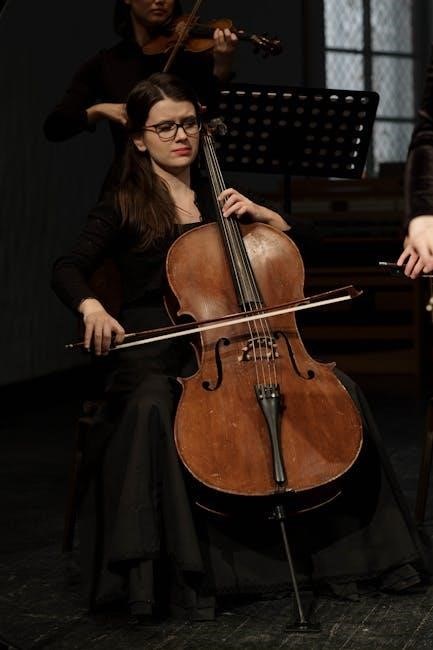The Cellist of Sarajevo: An Overview

Steven Galloway’s “The Cellist of Sarajevo,” available in PDF, tells the story of a cellist who plays Albinoni’s Adagio for twenty-two days. This act of defiance honors the twenty-two victims of a mortar attack during the Bosnian War.

The Cellist’s Act of Defiance
Inspired by a real-life cellist, Vedran Smailović, the titular character chooses to play Albinoni’s Adagio in G Minor. This act of profound defiance and remembrance takes place at the site of a mortar attack in Sarajevo.
Playing Albinoni’s Adagio in G Minor
The cellist’s decision to play Albinoni’s Adagio in G Minor is central to the narrative. This piece of music becomes a symbol of resistance and mourning in the war-torn city. Each note resonates with the pain and loss experienced by the citizens of Sarajevo. The Adagio, with its somber and reflective melody, serves as a lament for the lives lost and a testament to the enduring human spirit. It is a powerful act of defiance against the violence and destruction that surround him. The music provides solace amidst the chaos.
The Significance of Twenty-Two Days
The cellist’s commitment to playing for twenty-two consecutive days holds profound significance; Each day represents one of the twenty-two individuals killed in the mortar attack while waiting in a breadline. This act transforms the cellist’s performance into a powerful memorial, honoring each lost life with the beauty and sorrow of Albinoni’s Adagio. The twenty-two days become a period of reflection for the city, a time to remember the victims and acknowledge the devastating impact of the war. It is a symbol of respect and a poignant reminder of the human cost of conflict. The duration underscores the depth of mourning.

Sarajevo During the Siege
During the siege, Sarajevo faced immense hardship. “The Cellist of Sarajevo” depicts a city under constant threat, where everyday activities risked lives, and the human spirit was tested to its limits.
Geographical Context: The Miljacka River and Dinaric Alps
Sarajevo’s geographical setting, nestled within a valley, surrounded by the Dinaric Alps and bisected by the Miljacka River, plays a significant role in “The Cellist of Sarajevo.” This location, once celebrated for hosting the 1984 Winter Olympics, became a strategic point during the Bosnian War. The surrounding mountains facilitated the siege, allowing for constant bombardment of the city. The Miljacka River, a natural landmark, became a dividing line, both physically and symbolically, within the war-torn city. Galloway uses this setting to amplify the themes of isolation, vulnerability, and the resilience of the human spirit amidst conflict.
Impact of the Bosnian War
The Bosnian War, as depicted in “The Cellist of Sarajevo,” profoundly impacted the lives of ordinary citizens. The siege of Sarajevo created impossible moral choices, where everyday acts, like crossing the street, risked lives. The war fostered an environment of constant fear, scarcity, and loss. The novel explores how this siege revealed both the fortitude and frailty of the human spirit. Characters grapple with survival, morality, and the preservation of their humanity amidst violence. The war’s devastation serves as a backdrop against which acts of resistance and healing, such as the cellist’s performance, gain greater significance.

Characters and Their Moral Choices
“The Cellist of Sarajevo,” available as a PDF, presents characters facing impossible moral choices under siege. Their fortitude and frailty are tested daily as they navigate a war-torn city.
Kenan, Arrow, and Dragan
In “The Cellist of Sarajevo,” readily available in PDF format, Kenan, Arrow, and Dragan navigate a city under siege, each grappling with profound moral dilemmas. Kenan’s journey to secure water for his family highlights the everyday struggles for survival and the lengths people go to protect loved ones. Arrow, a sniper tasked with protecting the cellist, confronts the dehumanizing aspects of war and the conflict between duty and conscience. Dragan, an older man, reflects on the past and struggles to maintain his humanity amidst the violence. Their interconnected stories reveal the diverse ways individuals respond to the pressures of war, showcasing resilience, sacrifice, and the enduring search for meaning in chaos.

Themes in the Novel
“The Cellist of Sarajevo,” often accessed as a PDF, explores themes of human resilience amidst war. It highlights music’s power as resistance, and examines moral choices faced during conflict, revealing the fortitude and frailty of the human spirit.
The Human Spirit in the Face of Adversity
Within “The Cellist of Sarajevo,” readily available in PDF formats, a core theme revolves around the resilience of the human spirit. The narrative showcases individuals confronting unimaginable hardship during the siege. Characters like Kenan, Arrow, and Dragan navigate impossible moral choices, highlighting both strength and vulnerability. The everyday act of survival becomes a testament to fortitude.
The cellist’s unwavering performance amidst chaos symbolizes defiance and remembrance. This theme underscores humanity’s capacity to endure, find meaning, and preserve dignity even when facing devastation. The novel explores how individuals react, adapt, and, ultimately, strive to maintain their humanity.
Music as Resistance and Healing
In Steven Galloway’s “The Cellist of Sarajevo,” a theme explored, also accessible in PDF versions, is music’s function as resistance and healing. The cellist’s daily performance of Albinoni’s Adagio serves as a powerful act of defiance against the violence engulfing Sarajevo. Music becomes a form of protest, a way to reclaim humanity amidst destruction.
Furthermore, the novel suggests music possesses a healing quality, offering solace and a sense of connection to those affected by the war. It provides comfort and a collective experience in a city fractured by conflict. The melodies resonate, fostering a sense of hope and resilience.

Availability of “The Cellist of Sarajevo”
“The Cellist of Sarajevo” by Steven Galloway is available in PDF format for download. It can also be found in EPUB and Kindle formats, offering multiple access options.
PDF and Other Downloadable Formats
For those seeking to engage with Steven Galloway’s poignant narrative, “The Cellist of Sarajevo” is widely accessible in various digital formats. A PDF version allows for easy reading on computers and tablets, preserving the original formatting of the text. Additionally, the novel is available in EPUB format, optimized for e-readers, providing a reflowable text experience tailored to different screen sizes. Kindle versions are also readily obtainable, ensuring compatibility with Amazon’s popular e-reading devices and apps. These downloadable formats offer convenient ways to explore the novel’s themes of resilience, morality, and the power of art amidst conflict. The accessibility of “The Cellist of Sarajevo” in multiple digital forms extends its reach to a global audience.

Critical Reception and Analysis
“The Cellist of Sarajevo” has garnered significant critical acclaim for its powerful depiction of life during the siege of Sarajevo and its exploration of complex moral dilemmas. Reviewers have praised Galloway’s evocative prose and his ability to create compelling, relatable characters navigating extraordinary circumstances. The novel’s exploration of themes such as resilience, the human spirit, and the role of art in times of conflict has resonated with readers and critics alike. Some analyses focus on the symbolism embedded within the narrative, particularly the cellist’s music as a form of resistance and healing. The book’s unflinching portrayal of war’s impact on civilians has also been a subject of discussion, contributing to its lasting impact on contemporary literature. It is considered a heartbreaking and tense narrative.

Inspiration and Real-Life Parallels

The novel draws inspiration from Vedran Smailović, a cellist who played in war-torn Sarajevo. His music served as a lament, mirroring the fictional cellist’s act of defiance and remembrance amidst the siege.
Vedran Smailović and His Music
Vedran Smailović, the real-life inspiration behind “The Cellist of Sarajevo,” is a Bosnian cellist. During the siege of Sarajevo, Smailović famously played his cello in bombed-out locations, often at great personal risk. His actions were a powerful symbol of defiance and remembrance.
He played Albinoni’s Adagio in G Minor to honor those killed by the war. This act provided solace and a sense of shared humanity in a time of immense suffering. His music served as a poignant reminder of the lives lost and the enduring spirit of Sarajevo.
